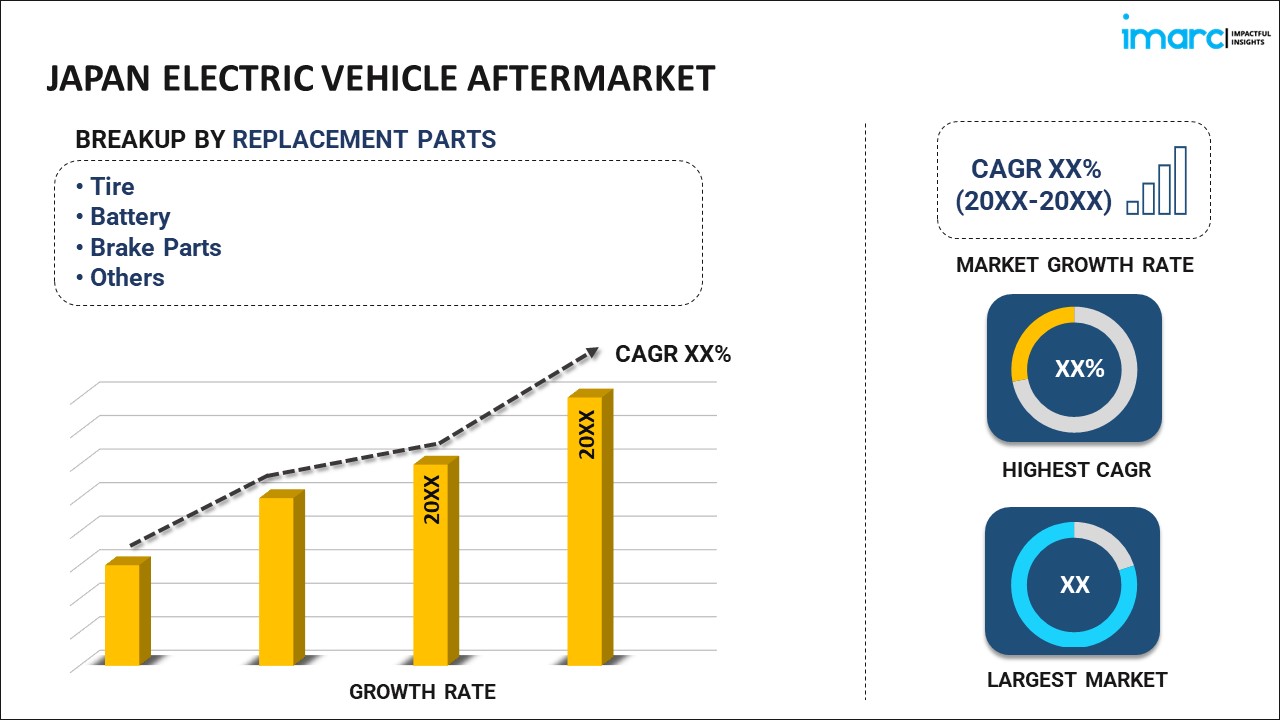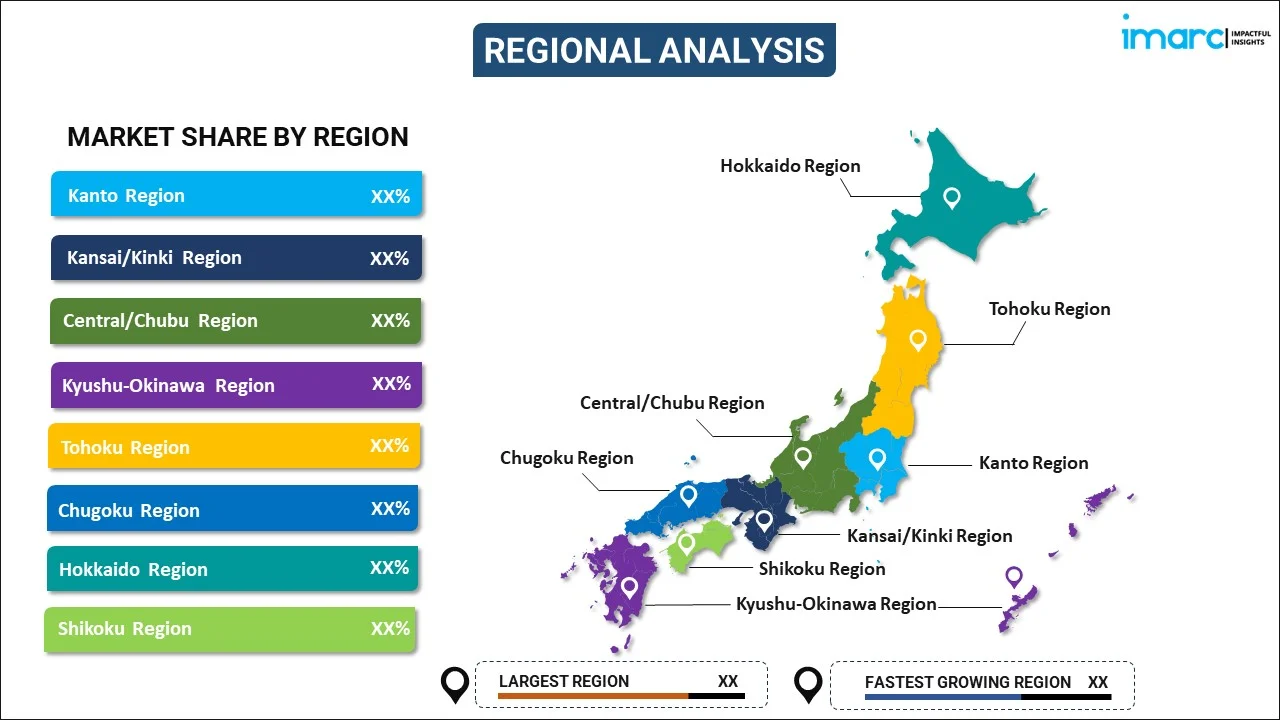
Japan Electric Vehicle Aftermarket Report by Replacement Part (Tire, Battery, Brake Parts, Filters, Body Parts, Lighting and Electronic Components, Wheels, Turbochargers, and Others), Propulsion Type (Battery Electric Vehicles, Hybrid Electric Vehicles, Fuel Cell Electric Vehicles, Plug-in Hybrid Electric Vehicles), Vehicle Type (Passenger Cars, Commercial Vehicles), Certification (Genuine Parts, Certified Parts, Uncertified Parts), Distribution Channel (Authorized Service Centers (OEMs), Premium Multi-brand Service Centers, Digital Aggregators, and Others), and Region 2025-2033
Market Overview:
Japan electric vehicle aftermarket size reached USD 4.8 Billion in 2024. Looking forward, IMARC Group expects the market to reach USD 21.7 Billion by 2033, exhibiting a growth rate (CAGR) of 18.3% during 2025-2033. The market is experiencing notable growth due to several key factors, including a rising demand for software-focused aftermarket companies that specialize in digital solutions, the widespread acceptance of over-the-air digital communication, and the emergence of substantial independent aftermarket (IAM) intermediaries.
|
Report Attribute
|
Key Statistics
|
|---|---|
|
Base Year
|
2024 |
|
Forecast Years
|
2025-2033 |
|
Historical Years
|
2019-2024
|
| Market Size in 2024 | USD 4.8 Billion |
| Market Forecast in 2033 | USD 21.7 Billion |
| Market Growth Rate (2025-2033) | 18.3% |
The electric vehicle aftermarket refers to the comprehensive array of products, services, and solutions tailored to meet the needs of electric vehicle (EV) owners beyond what the original manufacturer offers. With the increasing prominence of electric vehicles in the automotive industry, driven by their eco-friendliness and cost-effectiveness, the aftermarket has emerged as a source of diverse enhancements and modifications. This encompasses a wide spectrum of components and services, including, but not limited to, charging solutions, battery upgrades, performance adjustments, interior customization, and maintenance services. EV owners frequently turn to the aftermarket to personalize their vehicles, extend their driving range, enhance home charging infrastructure, or optimize overall performance. Companies specializing in the electric vehicle aftermarket concentrate on addressing the unique requirements of EVs, contributing significantly to the growth and innovation of this sector.
Japan Electric Vehicle Aftermarket Trends:
The Japanese market is witnessing a surge in demand for software-centric aftermarket companies that specialize in digital solutions, driving its growth. These enterprises are focused on innovative offerings such as intelligent parking services, which facilitate seamless parking transactions, and advanced road trip support that equips electric vehicles (EVs) with self-driving travel itineraries. Furthermore, the market is being propelled by original equipment manufacturers (OEMs) who leverage their exclusive access to EV-specific components. This includes convenient options like battery swapping and charging through exchange stations, as well as on-the-go assistance, effectively stimulating market expansion. The emergence of substantial independent aftermarket (IAM) intermediaries has also made a significant contribution to the increasing demand in Japan. These intermediaries invest in dedicated workshops tailored to EV owners, establishing a vital link between them and globally recognized suppliers. Another driving force in the market is the shift from reactive to proactive and prescriptive maintenance practices, enhancing customer satisfaction and brand loyalty. Additionally, the widespread adoption of over-the-air digital communication further enhances the market's prospects by offering remote diagnostics and real-time product updates, which will provide a boost to its overall growth in Japan over the forecasted period.
Japan Electric Vehicle Aftermarket Segmentation:
IMARC Group provides an analysis of the key trends in each segment of the market, along with forecasts at the country level for 2025-2033. Our report has categorized the market based on replacement part, propulsion type, vehicle type, certification, and distribution channel.
Replacement Part Insights:

- Tire
- Battery
- Brake Parts
- Filters
- Body Parts
- Lighting and Electronic Components
- Wheels
- Turbochargers
- Others
The report has provided a detailed breakup and analysis of the market based on the replacement part. This includes tire, battery, brake parts, filters, body parts, lighting and electronic components, wheels, turbochargers, and others.
Propulsion Type Insights:
- Battery Electric Vehicles
- Hybrid Electric Vehicles
- Fuel Cell Electric Vehicles
- Plug-in Hybrid Electric Vehicles
A detailed breakup and analysis of the market based on the propulsion type have also been provided in the report. This includes battery electric vehicles, hybrid electric vehicles, fuel cell electric vehicles, and plug-in hybrid electric vehicles.
Vehicle Type Insights:
- Passenger Cars
- Commercial Vehicles
The report has provided a detailed breakup and analysis of the market based on the vehicle type. This includes passenger cars and commercial vehicles.
Certification Insights:
- Genuine Parts
- Certified Parts
- Uncertified Parts
A detailed breakup and analysis of the market based on the certification have also been provided in the report. This includes genuine parts, certified parts, and uncertified parts.
Distribution Channel Insights:
- Authorized Service Centers (OEMs)
- Premium Multi-brand Service Centers
- Digital Aggregators
- Others
The report has provided a detailed breakup and analysis of the market based on the distribution channel. This includes authorized service centers (OEMS), premium multi-brand service centers, digital aggregators, and others.
Regional Insights:

- Kanto Region
- Kansai/Kinki Region
- Central/ Chubu Region
- Kyushu-Okinawa Region
- Tohoku Region
- Chugoku Region
- Hokkaido Region
- Shikoku Region
The report has also provided a comprehensive analysis of all the major regional markets, which include Kanto Region, Kansai/Kinki Region, Central/ Chubu Region, Kyushu-Okinawa Region, Tohoku Region, Chugoku Region, Hokkaido Region, and Shikoku Region.
Competitive Landscape:
The market research report has also provided a comprehensive analysis of the competitive landscape in the market. Competitive analysis such as market structure, key player positioning, top winning strategies, competitive dashboard, and company evaluation quadrant has been covered in the report. Also, detailed profiles of all major companies have been provided.
Japan Electric Vehicle Aftermarket Report Coverage:
| Report Features | Details |
|---|---|
| Base Year of the Analysis | 2024 |
| Historical Period | 2019-2024 |
| Forecast Period | 2025-2033 |
| Units | Billion USD |
| Scope of the Report | Exploration of Historical Trends and Market Outlook, Industry Catalysts and Challenges, Segment-Wise Historical and Future Market Assessment:
|
| Replacement Parts Covered | Tire, Battery, Brake Parts, Filters, Body Parts, Lighting and Electronic Components, Wheels, Turbochargers, Others |
| Propulsion Types Covered | Battery Electric Vehicles, Hybrid Electric Vehicles, Fuel Cell Electric Vehicles, Plug-in Hybrid Electric Vehicles |
| Vehicle Types Covered | Passenger Cars, Commercial Vehicles |
| Certifications Covered | Genuine Parts, Certified Parts, Uncertified Parts |
| Distribution Channels Covered | Authorized Service Centers (OEMs), Premium Multi-brand Service Centers, Digital Aggregators, Others |
| Regions Covered | Kanto Region, Kansai/Kinki Region, Central/ Chubu Region, Kyushu-Okinawa Region, Tohoku Region, Chugoku Region, Hokkaido Region, Shikoku Region |
| Customization Scope | 10% Free Customization |
| Post-Sale Analyst Support | 10-12 Weeks |
| Delivery Format | PDF and Excel through Email (We can also provide the editable version of the report in PPT/Word format on special request) |
Key Questions Answered in This Report:
- How has the Japan electric vehicle aftermarket performed so far and how will it perform in the coming years?
- What has been the impact of COVID-19 on the Japan electric vehicle aftermarket?
- What is the breakup of the Japan electric vehicle aftermarket on the basis of replacement part?
- What is the breakup of the Japan electric vehicle aftermarket on the basis of propulsion type?
- What is the breakup of the Japan electric vehicle aftermarket on the basis of vehicle type?
- What is the breakup of the Japan electric vehicle aftermarket on the basis of certification?
- What is the breakup of the Japan electric vehicle aftermarket on the basis of distribution channel?
- What are the various stages in the value chain of the Japan electric vehicle aftermarket?
- What are the key driving factors and challenges in the Japan electric vehicle aftermarket?
- What is the structure of the Japan electric vehicle aftermarket and who are the key players?
- What is the degree of competition in the Japan electric vehicle aftermarket?
Key Benefits for Stakeholders:
- IMARC’s industry report offers a comprehensive quantitative analysis of various market segments, historical and current market trends, market forecasts, and dynamics of the Japan electric vehicle aftermarket from 2019-2033.
- The research report provides the latest information on the market drivers, challenges, and opportunities in the Japan electric vehicle aftermarket.
- Porter's five forces analysis assist stakeholders in assessing the impact of new entrants, competitive rivalry, supplier power, buyer power, and the threat of substitution. It helps stakeholders to analyze the level of competition within the Japan electric vehicle aftermarket industry and its attractiveness.
- Competitive landscape allows stakeholders to understand their competitive environment and provides an insight into the current positions of key players in the market.
Need more help?
- Speak to our experienced analysts for insights on the current market scenarios.
- Include additional segments and countries to customize the report as per your requirement.
- Gain an unparalleled competitive advantage in your domain by understanding how to utilize the report and positively impacting your operations and revenue.
- For further assistance, please connect with our analysts.
 Inquire Before Buying
Inquire Before Buying
 Speak to an Analyst
Speak to an Analyst
 Request Brochure
Request Brochure
 Request Customization
Request Customization




.webp)




.webp)












